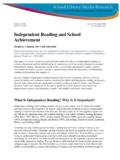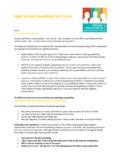Transcription of A Guide to Contracting Out School Support Services: Good ...
1 A Guide to Contracting Out School Support services : good for the School ? good for the Community? William J. Mathis, Rutland Northeast Supervisory Union Lorna Jimerson, Ed. D. Champlain Valley Union High School The Great Lakes Center for Education Research & Practice PO Box 1263 East Lansing, MI 48826 Phone: (517) 203-2940 Email: Web Site: March 2008 Guide to Contracting Out School Support services 1 of 30 Guide to Contracting Out School Support services : good for the School ? good for the Community? William J. Mathis, Superintendent of Schools, Rutland Northeast Supervisory Union Lorna Jimerson, Champlain Valley Union High School , Board of School Directors Executive Summary Contracting out using private contractors to provide Support services has received increasing attention in the nation s public schools. In a climate promoting market models and privatization, the increasing popularity of School choice and education management organizations has encouraged countless vendors to attempt privatizing a wide array of public School services .
2 The largest and most visible efforts have targeted food, transportation and custodial services . International and national mega-corporations are increasingly consolidating the food services and transportation industries, in particular. Virtually all School systems have historically used and continue to use private vendors to some degree. In many cases, Contracting out is simply the most efficient, practical and prudent path. Yet, the appealing promises of commercial vendors to provide higher quality services at cheaper prices while relieving administrative headaches are not always realized. This paper reviews critical considerations for School officials considering Contracting out. These include hidden costs, quality control. impact on administrative time, social costs, and loss of control and restricted flexibility. When deciding whether to contract out, it is recommended that School leaders first: Analyze the reasons for considering a private vendor and determine whether underlying administrative and cost issues might be more efficiently and economically resolved internally.
3 Often, a consultant can expedite this review. Conduct a careful cost analysis of contractor proposals, including hidden, indirect, and administrative costs to the district. Such an analysis is essential to determine if Contracting out is cost-effective. Guide to Contracting Out School Support services 2 of 30 Weigh the social costs of privatization, such as possible economic harm to employees and to the community and potential disruption of School -community relations. Determine if there are enough qualified potential bidders to provide the effective competition and substantial cost reduction that the market model promises. When a decision to contract out has been made, School leaders should: Develop requests for proposals (RFPs) using independent resources and advice rather than a vendor s model contract or specification materials. Have an outside expert in the service area as well as legal counsel review the RFP and the proposals.
4 Assure that sufficient quality control measures are in the contract. For example, effective monitoring, dispute resolution procedures, cost penalties and provisions for contract cancellation must be explicit, clear and free of excessive conditions. Check the contractor s performance with other districts and the appropriate state agency. It is important to look beyond the references on the vendor s list. Examine the contractor s plans and guarantees regarding the district s existing, new, and future employees. Determine whether a cost reduction will come at the expense of employees and the social well-being of the community. In the district s cost analysis, determine what new costs the district may incur as a result of Contracting out. For example, will the district have to hire a program monitor, buy supplies, or provide maintenance? To avoid unanticipated and unbudgeted bills, check the vendor s cost estimates on staffing, wages, inflation, energy costs and the like for reasonableness.
5 Assure that such costs are appropriately capped. Ascertain if the thresholds for additional billed services are realistic and fairly priced. Check cancellation provisions to prevent the district from being held captive to a contractor. Districts should avoid selling assets like kitchen equipment and bus fleets, which would effectively prevent their return to the district s own operation. Guide to Contracting Out School Support services 3 of 30 A Guide to Contracting Out School Support services : good for the School ? good for the Community? William J. Mathis, Superintendent of Schools, Rutland Northeast Supervisory Union Lorna Jimerson, Champlain Valley Union High School , Board of School Directors1 Introduction Across the country, School boards and School administrators are continuously barraged with demands from political groups and low-tax advocates for high quality education at the lowest possible price.
6 Concurrently, the federal No Child Left Behind accountability system places pressures and penalties on already stretched School systems to introduce new, intensive and expensive programs, particularly for poor, special education, and minority students as well as English Language Learners. The costs of health care and utilities continue to explode, consuming ever-increasing shares of educational budgets. Increases in special education expenditures, coupled with federal under-funding, out-run inflation and now approach 20% of School New and expanded mandates in areas such as air quality, allergy prevention, bus idling, bullying, equal opportunities, family leave, gender equity, hazing and harassment, School lunches, bookkeeping, sports, and still other areas all add costs to a district s bottom line. Into this context come privatization advocates and vendors, extolling how much money can be saved by Contracting out School Support Certainly such promises are exceptionally attractive to people in dire circumstances.
7 But such promises must be examined carefully. This brief is intended to help School leaders superintendents, School board members, School business officials and principals who are considering Contracting out Support services . The goal is to provide relevant background and context, discuss some potential problems, and pose critical considerations to help leaders make good decisions. Methods The recommendations made in this paper are based on a review of research literature related to the practice of Contracting out Support services in public schools. Studies were included in the review if they met one or more of the following criteria: Guide to Contracting Out School Support services 4 of 30 Addressed Contracting out for student Support services within a public School context, especially for the major Contracting areas of transportation, food services and custodial Support . Offered concrete data on the incidence of Contracting out and trends over time.
8 Presented empirical and objective evidence of the success or failure of privatized services in terms of cost savings and quality. Were relatively current, generally (though not exclusively) having been published within the past ten years. Had practical value for educational leaders relative to Contracting out. We found few research studies in peer-reviewed journals and literature that met our criteria. Typically, we found case Somewhat puzzling was the lack of research after 2000. Much more numerous were papers written by pro-privatization and anti-privatization organizations. Most of these, however, promoted a particular position without offering supporting empirical data. Some were nevertheless included in our review if they amplified the context of privatization or supplied specific examples that illuminated a particular discussion. Otherwise, they were excluded.
9 A few pre-existing literature reviews, surveys and case studies informed our work. Warner and Hefetz5 present a comprehensive review of literature on privatized services . Although not specific to schools, they analyzed data from a large national survey administered every five years to local governments, and their work highlights the important issues of cost savings, transactional costs, community values and stability of contracts. In addition, we frequently refer to a multiple-case study from This research is unique in that it explicitly examines the actual language within contracts and the data used in cost-benefit presentations. This work is specific to non-instructional School Support services and is, therefore, especially relevant to our intended audience of School practitioners and board members. Materials reviewed also included survey data published by the Mackinac Center, American School & University magazine, and School Bus Fleet magazine.
10 We also found, and occasionally cite, media reports that provided examples of specific situations and concerns that School districts encountered. Finally, though we were particularly interested in non-instructional, or student Support services , we briefly review literature on the privatization of entire School systems. This literature is essential in placing the Contracting out of Support services within the larger movement to privatize education. Guide to Contracting Out School Support services 5 of 30 Background and Context of Contracting Out The Appeal of Privatization Contracting out is widely touted as a way for School districts to save money, increase efficiency and improve the quality of services . It also purportedly frees School leaders from non-instructional responsibilities so that they can concentrate on their primary mission of ensuring that children are On their face, these are compelling and appealing arguments.










